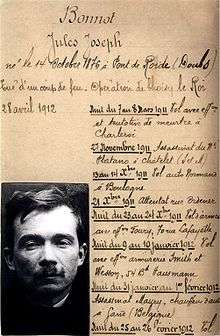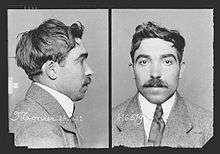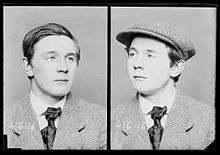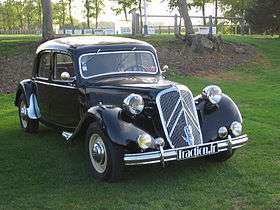Milieu (organized crime in France)
Primarily, organized crime in France is based in its urban, major cities such as Marseille, Grenoble, Paris, and Lyon. Organized criminals are collectively known as the French Mob and singularly known as les beaux voyous (French: [le bo vwaju]; i.e. "the goodfellas") operating within Le Milieu (French: [lə miljø]; i.e. "the underworld").[note 1][1][2]
 1912 police photo of Jules Bonnot, founder of one of the first French Mobs–the Bonnot Gang | |
| Founding location | France |
|---|---|
| Territory | Marseille, Grenoble, Lille Paris, and Lyon |
| Ethnicity | Predominantly continental French, Corsican, Arab French, Algerian, and French Blacks |
| Criminal activities | money laundering, prostitution, drug trafficking, arms trafficking, bookmaking, assault, extortion, fraud, murder, fencing, bribery, smuggling, hijacking, counterfeiting and robbery |
| Allies | Varies on criminal group |
| Rivals | Varies on criminal group |
From the 1900s to the late 1930s, activities within Le Milieu were primarily prostitution, bookmaking, fencing, and hijacking. Favored criminal activity in France turned to bank robbery, drug trafficking, and smuggling from 1940 to the late 1970s. The 1980s saw a resurgence of large-scale bank robberies and heists. From 1990 to 2000, criminal organizations established complex extortion rings in Marseille extending to Aix-en-Provence and the greater French Riviera. Since 2002, Le Milieu is known for, in addition to its extortion rings, large counterfeiting and white-collar crime operations. Due to increased financial regulation, Le Milieu has collectively pushed to integrate their crime profits into the legal economy.
France's geographical location makes it an attractive venue for trafficking (i.e. smuggling) and counterfeiting. The port of Marseille is a hub for Le Milieu to move large amounts of product into domestic and European markets.[3] Low economic development continues to be the largest factor in youth joining French criminal organizations.
The most prominent criminal organization within Le Milieu is the Corsican mafia (milieu corse). Although the mafia has encompassed many criminal groups from the 1960s to the 1980s, modern (1990s–present) criminal activity is managed by the Marseille-based Unione Corse and Northern Corsica-based Gang de la Brise de Mer (i.e. "the sea breeze gang"). In 2007, an internal conflict led to the deaths of 102 people on the island of Corsica fracturing the influence of the two larger groups.[4] These two mobs remain powerful as of 2018, often controlling nightclubs, bars, restaurants, apartments, and hotels in Aix-en-Provence, Marseille and the French Riviera. In 2016, it was estimated that France's organized crime net US$23 billion in its underground economy.[5]
Terms used
The term Milieu literally means middle and figuratively society or environment and refers to the set of criminal figures operating in the French metropolitan areas who are known to the public for being involved in high level organized crime. Members working within the Milieu are collectively known as the French Mob. This category does not include criminal organizations that were formed in another country and operate within France (e.g. the Italian Camorra, Serbian Mafia, Albanian mafia, Chinese Triads, or Turkish Kurd PKK).[6][7] French mobs considered within the milieu are usually ones with long-standing ties to the country.[8] An increase in youth-centered gang activity lead to the separation of the Milieu.[3]
- "Traditional Milieu" (1930 to 1989): encompasses the older, foundational criminal organizations of the French underworld
- "French Corsican mafia" or "Milieu corso-marseillais" (1990–present): encompasses the newer, modern criminal groups in France and Corsica
Organization

Due to the early historical connection the Corsican mafia shares with the Sicilian one, the modern structure of most French mobs typically break down into crime families with a strict hierarchy. Usually the goodfellas that carry out "orders" are known as une équipe multi-qualifiée (i.e. a multi-skilled team) composed of les beaux voyous (i.e. "the good fellows"). Most of these groups of members maintain and protect "mouvances" (i.e. territory).[2] Members of the French Mob are highly professional as compared to lower-level crime groups in that they usually split their work by specialty (e.g. some members serve as the "brain", while others the "muscle" and/or "specialist".[2]
- Caïd (French: [kay-id] "the big boss"; "the boss")
- Parrain (French: [pah-rahn] "godfather")
- Spécialiste (French: [speh-sjah-leest] "specialist")
- Associés ("associate")
- Beaux voyous ([bow vwah-yo] "goodfella"; "the good fellows")
Externally, and more generally, the organization of the French mob is as follows:[2][7][6]
- Le Milieu (French: [luh mil-yuh]) "the underworld") / The French Mob: a general term for criminal organizations in France
- Mafia-type criminal organizations (e.g. the Corsican mafia): a criminal organization composed of crime families with structural roots in the Sicilian Mafia
- Gangs (e.g. Rédoine Faïd gang, Gang des postiches): a smaller criminal group with a soft hierarchy
- Crime families (e.g. Carbone crime family): a subset of a mafia-type organization that executes orders and/or missions
Activities and strategies
According to a 2004 study on organized crime, the activities of criminals within the French underworld typically fall into three broad categories:[2]
- Wholly illegal activity: criminal activities that are blatantly and duly illegal e.g. racketeering, kidnapping, armed robbery, trafficking, assault, etc.
- Associative illegal activity: criminal activities associated with their main wholly illegal activities e.g. bribery, corruption of police officials, tax fraud, grand theft auto, etc.
- Legal activity: activities used to cover up illegal activities e.g. operating a business for money laundering purposes, running gambling machines, restaurants, etc.
History
Origins: 1910s to 1920s
.png)
The history of organized crime in France can be traced to the French Revolution (1789 to 1799). It is however with the turn of the 20th century that local mobsters became highly organized and created crime families. During the 1910s and 1920s, Pigalle and Rue Saint-Denis (in Paris) served as a hub for prostitution.[2] Due to decentralized political control in Corsica during the 1900s, many criminal organizations flourished. Members of these gangs moved from the island of Corsica to the southern coasts of France during the early 20th century. From 1920 to 1930, prostitution was the most important criminal activity, controlled in Marseille by the Corsican Godfather, Paul Carbone and the Italian-French Godfather François Spirito.[2] In Paris, the Pigalle area were fought over by Corsican godfathers such as Jean-Paul Stefani and Ange Saliceti.
"French Connection": 1930s to 1970s
During the 1940s and 1950s, many gangs — most notably the Tractions Avant gang – committed large scale bank robberies. During the 1970s, the most powerful gang in Paris was the Zemmour crime family, a Jewish/pied noir clan. The Zemmour brothers controlled prostitution in the French capital and were considered to be Godfathers of Paris.[2] As prostitution decreased, criminal activities turned to more white-collar crimes. In 1930, the two godfathers spearheaded the French Connection – a global heroin smuggling ring reaching its peak in the 1960s and 1970s. Drugs were smuggled from Turkey to France and then to the United States through Canada. The French Connection was guided by various crime families into the late 1970s before it was disbanded by French authorities. The "Milieu of Marseille" (i.e. "the underworld of Marseille")[2][5] was left without political leadership after the French Connection was destroyed.[2] The Unione Corse established widespread infrastructure in the 1930s and helped guide the Milieu out of the French Connection era.[9]
"The Godfathers of Paris": 1980s

During the 1980s, many "godfathers" (e.g. Tany Zampa, Jacky Imbert, and Francis Vanverberghe) fought for control over racketeering and drug trafficking in the port area of the city. It was during this time that the Zemmour brothers — known as "The Godfathers of Paris" — were killed. Claude Genova quickly assumed the gap the brothers left and continued running low-level prostitution rings until his 1994 assassination. The Gang des postiches robbed nearly 30 banks during their run from 1981 to 1986. Claude Genova's connections and infrastructure was overtaken by the Hornec brothers in 1994.
Push to extortion: 1990–2000
At the start of the 1990s, cities were split up by families or "godfathers"[5] (parrains). Larger cities, however, were fractured into various "mouvances" (territories). Many of these crime families established complex extortion rings in Marseille extending to Aix-en-Provence and the greater French Riviera.

The Rédoine Faïd gang, during the mid-1990s committed armed robbery, jewel theft, and extortion in the Paris area.[10][11][12] The leader of the gang, Rédoine Faïd, was arrested in 2011. He broke out of prison on 13 April 2013 with a staged bombing and fled, but was captured on 29 May 2013.[13][14][15]
Revitalization: 2000–present
Minority members of French society are being lured into crime families as a way of "fitting in". Low economic growth in the south of France is also leading youth to join the ranks as drug mules to gain an income alternative.[3] An increase in youth-centered gang activity lead to the separation of the Milieu. Since the 1990s, the French Corsican mafia (Milieu corso-marseillais has encompassed the newer, modern criminals in an effort to distinguish them from the "traditional Milieu" (1930s to 1980s).[3]
During the early 2000s, French Maghrebis (Algerians, Tunisians and Moroccans) living in impoverished suburbs created the Les Caïds des Cités (i.e. "rent-controlled housing crime lords"). Members of this group extort landlords in most major French cities.[16][17][18][19] In August 2012, Les Caïds became involved in drug and weapons trafficking which led to the death of 14 civilians.[20]
Inter-gang fighting led to a spike in murder rates on the island of Corsica in 2008.[21] In 2010, The "Venzolasca Gang" penetrated large amounts of territory previously occupied by the Brise de Mer Gang.
In 2011, it was reported that various North African gangs had moved to the suburbs of Paris in order to sell crack cocaine.[22] Members of these gangs introduced heroin and pure cocaine to their business operations in 2015.[23][24][25] On 18 October 2011, a large holding of art was stolen from the Musée des Beaux-Arts in Ajaccio, Corsica, by the Valinco, Brise de Mer, and Venzolasca gangs.[26]
In 2014, there was also an influx of "Voyageurs" or "Traveller" gangs in Paris, Marseille, Grenoble, and Montpellier. The most famous of them is the Hornec crime family;[18] they regularly participate in robberies, extortion, drug trafficking, prostitution, and illegal slots machines. Their hubs of operation are in the Camargue and the Étang de Berre regions.[18]
List of French mobs
The following lists contains historical and contemporary renditions of organized crime groups originating and/or operating in France. Mobs that also serve as crime families are denoted accordingly.
| † | Mob and crime family |
| Name | Location | Activities | Known Status |
|---|---|---|---|
| Gang des postiches | Paris | bank robberies | 1981 and 1986 |
| Bonnot Gang† | All major cities | racketeering | 1911 to 1912 |
| Gang des Tractions Avant | Paris | bank robberies | 1915 to 1950s |
| Bande des Trois Canards | Marseille | burglaries, hold-ups and racketeering | 1950 to 1965 |
| Rédoine Faïd gang† | Paris | armed robbery, jewel theft, and extortion | 1990 to 2013 |
| Hornec gang† | Paris | racketeering, drug dealing, illegal slot machines | 1980–present |
| Unione Corse | Marseille | racketeering, drug dealing, extortion, bank robbery | 1920–present |
| Gang de la Brise de Mer | Marseille | racketeering, drug dealing, extortion, bank robbery | 1970s–present |
| Les Caïds des Cités | Paris | rent-controlled property extortion, drug trafficking | 2000–present |
| Venzolasca Gang[26] | Corsica | racketeering, drug dealing, extortion | 2010–present |
| Valinco Gang[26] | Valinco | extortion | 2011–present |
| La bande du Petit Bar[27] | Ajaccio | extortion, drug trafficking | 2013–present |
List of crime families

Crime families in France are smaller units of mobs (i.e. a crime syndicate) which are in-turn either smaller units of a mafia group or the general Milieu. Alternately the phrase "crime family" could also mean the entirety of a mob, if it is small enough.[8] The following list encompasses groups that are solely crime families and do not double as French mobs:
- Unione Corse (Marseille, France and Ajaccio, Corsica)
- Francisci crime family
- Guerini brothers
- Orsini crime family
- Venturi crime family
- Carbone crime family
- Conein crime family
- Sarti crime family
- Mondoloni crime family
- Brise de mer gang (Bastia, northern Corsica and France)
- Mariani crime family
- Casanova crime family
- Guazzelli crime family
- Patacchini crime family
- Colonna crime family (southern Corsica)
In popular culture
- On Her Majesty's Secret Service (1963), James Bond novel wherein a character heads the French Mafia and is of Corsican descent.[28]
- The French Connection (1971), American film on the heroin trade, based on the book of the same name
- Les Brigades du Tigre (2006), French crime film loosely based on the Le Milieu
- In the film American Gangster (2007), the Corsican mafia attempt to murder Frank Lucas after he puts them out of business through his monopoly on the heroin trade in Harlem.
- A Prophet, 2009 French drama film centering on a petty criminal who rises in the Corsican mob
- 22 Bullets (2010), French film based on the leader of the Bande des Trois Canards, Jacky Imbert
See also
- Crime in France
- Corsican mafia
- Sicilian mafia
- Russian mafia
- Greek mafia
References
Notes
- Literally defined as: "middle" or "the environment"
Descriptively defined as "the underworld" i.e. a world outside of the law
Citations
- Lalam, Nacer, "How organised is organised crime in France?" in Organised Crime in Europe: Concepts, Patterns and Control Policies in the European Union and Beyond
- Fijnaut, Cyrille; Paoli, Letizia (2004-12-09). Organised Crime in Europe: Concepts, Patterns and Control Policies in the European Union and Beyond. Springer Science & Business Media. ISBN 9781402026157.
- Oved, Marco Chown (2016-07-25). "Terrorism doesn't pay in Marseille, but organized crime does". The Toronto Star. ISSN 0319-0781. Retrieved 2018-01-12.
- "Corsica Organized Crime On The Rise". The Huffington Post. Retrieved 26 December 2014.
- "Organized crime in Europe: A country-by-country breakdown | The Mob Museum". The Mob Museum. 2015-06-23. Retrieved 2018-01-12.
- "Tamil Tiger Mafia, a major threat to French society – Jérôme Pierrat". Retrieved 26 December 2014.
- "La camorra Paris : quand le boss roulait sa Lamborghini sur les Champs - AgoraVox le mdia citoyen". AgoraVox. 30 April 2010. Retrieved 26 December 2014.
- Organised Crime in Europe. Retrieved 26 December 2014.
- "The World: The Milieu of the Corsican Godfathers". TIME.com. 4 September 1972. Retrieved 26 December 2014.
- "Huit jours pour juger les braqueurs". Le Parisien (in French). 8 October 2001. Retrieved 14 April 2013.
- "La PJ coffre Rédoine Faïd, le braqueur médiatique" (in French). 28 June 2011. Retrieved 14 April 2013.
- "French prisoner escapes after dynamiting through doors". Telegraph. 13 April 2013. Retrieved 14 April 2013.
- "Top French gangster in spectacular jailbreak". AFP. 14 April 2013. Retrieved 14 April 2013.
- "Fin de cavale en Seine-et-Marne pour le braqueur Redoine Faïd", leparisien.fr, 29 May 2013
- "France's most wanted, gangster Redoine Faid, uses explosives to blast out of jail". The Australian. 14 April 2013. Retrieved 14 April 2013.
- "Le Figaro - Actualités". Retrieved 26 December 2014.
- "Les caïds de cité succèdent aux Italo-Grenoblois". Le Figaro. Retrieved 26 December 2014.
- cites2grenoble. "A Grenoble Caid de cits et manouches s'affrontent dans une guerre sans merci". Skyrock. Retrieved 26 December 2014.
- "Les caïds des cités, nouveaux rois du milieu marseillais". leparisien.fr. 26 December 2014. Retrieved 26 December 2014.
- "Marseille Drug War Killings: Government Refuses to Send in Army". International Business Times UK. Retrieved 26 December 2014.
- "France - Corsica, a local breed of violence". France 24. Retrieved 26 December 2014.
- "Mission d'information sur les toxicomanies : compte rendu de la semaine du 23 mai 2011". Retrieved 26 December 2014.
- "Guerre des Dealers dans une Cité Interdite". lefigaro.fr. Retrieved 24 June 2015.
- Le Point, magazine. "L'or blanc des Blacks des cités". Archived from the original on 26 December 2014. Retrieved 26 December 2014.
- "Nouveaux gangs, les caïds des cités tiennent les stups". marianne.net. Retrieved 24 June 2015.
- "Eleven suspects examined for Musée des Beaux-Arts robbery in Ajaccio | AMA | Art Media Agency". en.artmediaagency.com. Retrieved 2018-01-15.
- "Corse : la bande du Petit Bar démantelée". leparisien.fr. 2013-10-04. Retrieved 2018-01-15.
- Benson, Raymond (2015-12-07). The James Bond Bedside Companion. Crossroad Press.
External links
- Oliver Jungen Wenn der Bock zum Gärtner wird, Frankfurter Allgemeine Zeitung (in German), 7 February 2017, retrieved 27 June 2017
- Ursula Scheer Geldwäsche in Germania, Frankfurter Allgemeine Zeitung (in German), 16.06.2015, retrieved 27 June 2017